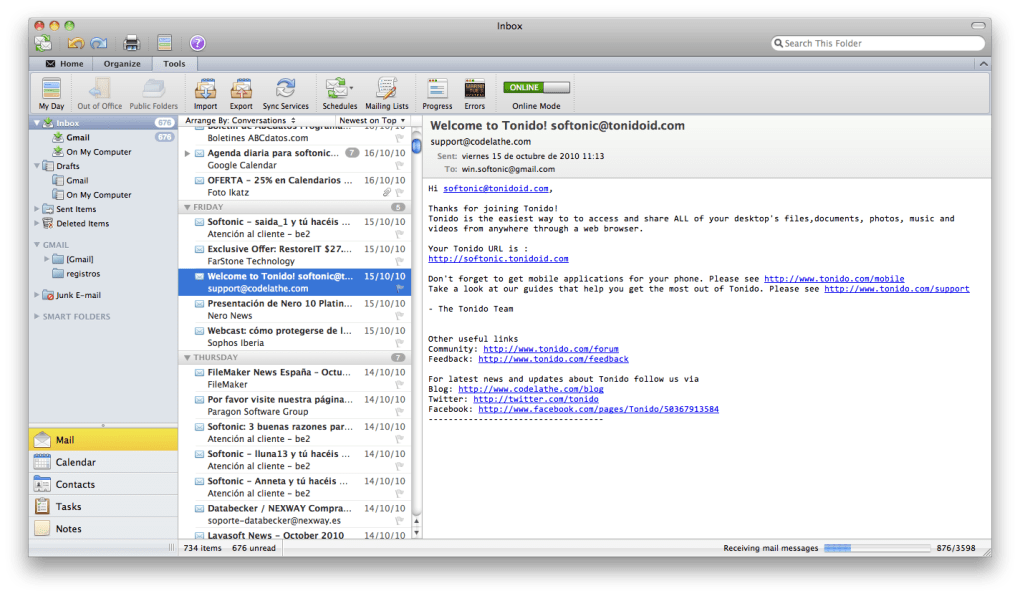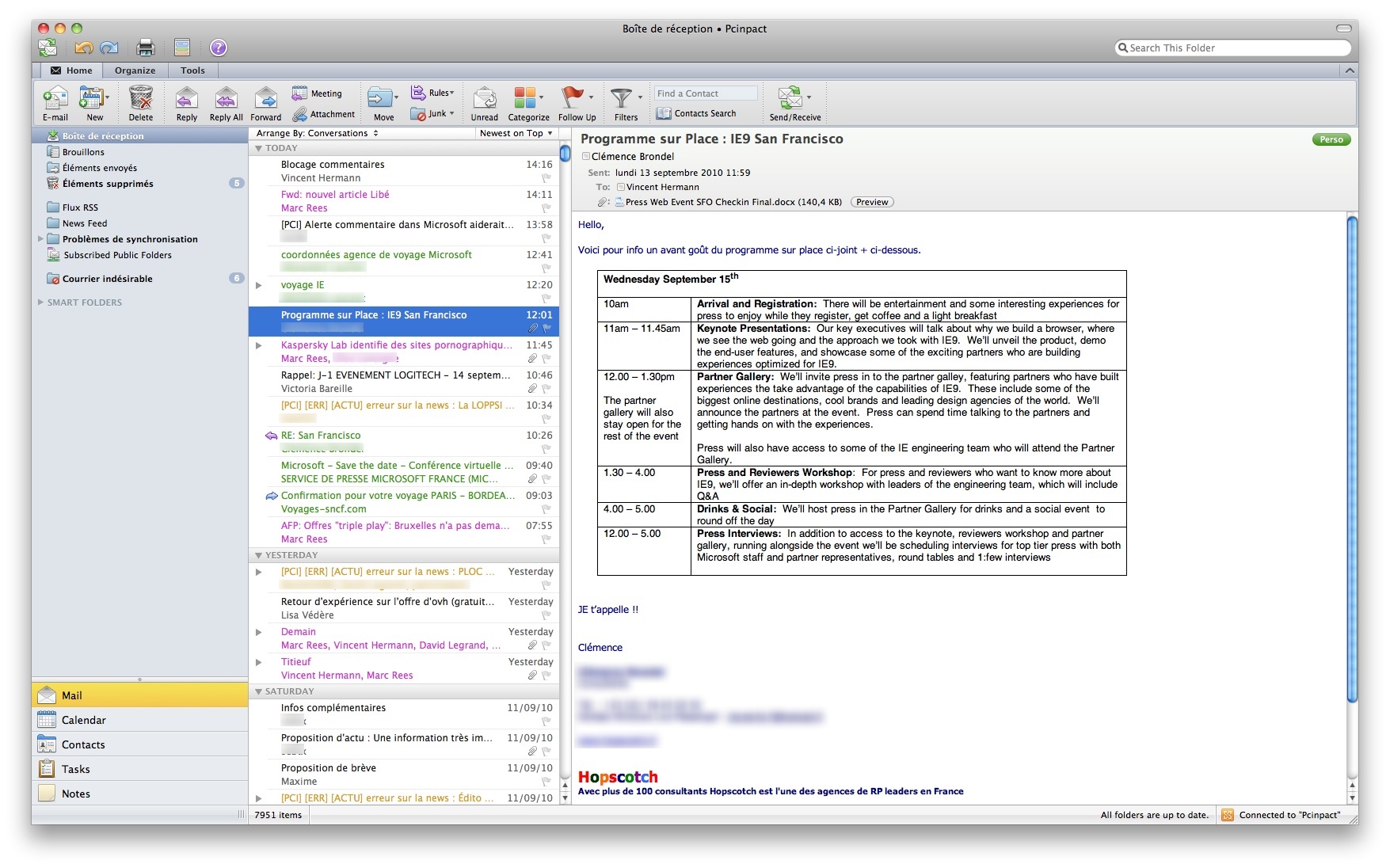Outlook for Mac works with Microsoft Exchange, Microsoft 365, Outlook.com (including Hotmail and MSN), Gmail, Yahoo Mail, and iCloud Learn more about Microsoft 365 Microsoft 365 is a cloud-based subscription service that brings together premium versions of Word, Excel, PowerPoint, Outlook and OneDrive, with the best tools for the way people. Start quickly with the most recent versions of Word, Excel, PowerPoint, Outlook, OneNote and OneDrive —combining the familiarity of Office and the unique Mac features you love. Work online or offline, on your own or with others in real time—whatever works for what you’re doing. Important note for Microsoft 365 subscriptions: After September 22, 2016, Office 2011 for Mac is no longer available for installation with a Microsoft 365 subscription.This doesn't affect one-time purchases of Office for Mac 2011 such as, Office Home and Student, Office Home and Business,. Outlook for Mac 2011 is a new e-mail client and personal information manager from Microsoft, not just an upgrade to its predecessor, Entourage 2008 ( ). Outlook 2011 has some features that. Outlook for Mac 2011. Outlook 2016 for Mac. Weather forecast in calendar. Share availability (free/busy) information, calendar, or contacts. Overlay calendars. Side-by-side calendars. Calendar preview in meeting requests. When you view a meeting invitation, Outlook automatically displays your calendar.
Microsoft Office for Mac 2011 applications shown on Mac OS X Snow Leopard | |
| Developer(s) | Microsoft |
|---|---|
| Initial release | October 26, 2010; 9 years ago |
| Stable release | |
| Operating system | Mac OS X 10.5.8 to macOS 10.14.6 |
| Type | Office suite |
| License | |
| Website | www.microsoft.com/mac/ |


Microsoft Office for Mac 2011 is a version of the Microsoft Officeproductivity suite for Mac OS X. It is the successor to Microsoft Office 2008 for Mac and is comparable to Office 2010 for Windows. Office 2011 was followed by Microsoft Office 2016 for Mac released on September 22, 2015, requiring a Mac with an x64 Intel processor and OS X Yosemite or later.
New features[edit]
Microsoft Office 2011 includes more robust enterprise support and greater feature parity with the Windows edition. Its interface is now more similar to Office 2007 and 2010 for Windows, with the addition of the ribbon. Support for Visual Basic for Applications macros has returned after having been dropped in Office 2008.[4][5] Purchasing the Home Premium version of Office for Mac will not allow telephone support automatically to query any problems with the VBA interface. There are however, apparently, according to Microsoft Helpdesk, some third party applications that can address problems with the VBA interface with Office for Mac.[citation needed] In addition, Office 2011 supports online collaboration tools such as OneDrive and Office Web Apps, allowing Mac and Windows users to simultaneously edit documents over the web. It also includes limited support for Apple's high-density Retina Displays, allowing the display of sharp text and images, although most icons within applications themselves are not optimized for this.
A new version of Microsoft Outlook, written using Mac OS X's Cocoa API, returns to the Mac for the first time since 2001 and has full support for Microsoft Exchange Server 2007.[6] It replaces Entourage, which was included in Office 2001, X, 2004 and 2008 for Mac.[7]
Limitations[edit]
Office for Mac 2011 has a number of limitations compared to Office 2010 for Windows. It does not support ActiveX controls,[8] or OpenDocument Format.[9][10] It also cannot handle attachments in Rich Text Format e-mail messages sent from Outlook for Windows, which are delivered as winmail.dat attachments.[citation needed] It also has several human language limitations, such as lack of support for right-to-left languages such as Arabic, Persian, and Hebrew [11] and automatic language detection. [12]
Microsoft does not support CalDAV and CardDAV in Outlook, so there is no way to sync directly Outlook through iCloud. Outlook also does not allow the user to disable Cached Exchange Mode, unlike the Windows version, and it is therefore not possible to connect to an Exchange Server without downloading a local cache of mail and calendar data. [13]

Office for Mac 2011 also has a shorter lifecycle than Office 2010, with support phasing out on October 10, 2017.[14] As 32-bit software, it will not run on macOS Catalina, released in 2019.[15]
Editions[edit]
Two editions are available to the general public. Home & Student provides Word, Excel and PowerPoint, while Home & Business adds Outlook and increased support.[16]Microsoft Messenger 8 is included with both editions, and Microsoft Communicator for Mac 2011, which communicates with Microsoft Lync Server, is available only to volume licensing customers.[17] Office 2011 requires an Intel Mac running Mac OS X 10.5.8 or later.[18]
| Applications and services | Home & Student | Home & Business | Academic | Standard |
|---|---|---|---|---|
| Word | Included | Included | Included | Included |
| PowerPoint | Included | Included | Included | Included |
| Excel | Included | Included | Included | Included |
| Outlook | Not included | Included | Included | Included |
| Communicator or Lync | Not included | Not included | Included | Included |
| Office Web Apps | Included | Included | Included | Included |
| Remote Desktop Connection | Not included | Included | Included | Included |
| Information Rights Management | Included | Included | Included | Included |
| Windows SharePoint Services Support | Not included | Included | Included | Included |
| Technical support | 90 days | 1 year | 90 days | ? |
The Home & Student edition is available in a single license for one computer and a family pack for three computers. The Home & Business edition is available in a single license for one computer and a multi-pack for two computers. The Standard edition is only available through Volume Licensing.[19] The Academic edition was created for higher education students, staff and faculty, and includes one installation.[20] Office for Mac is also available as part of Microsoft's Office 365 subscription programme.
Development[edit]
Microsoft announced Office 2011 in 2009.[21] There were 6 beta versions released:
- Beta 1
- Beta 2 (Version 14.0.0, Build 100326)
- Beta 3 (Build 100519)—announced on May 25, 2010[22]
- Beta 4 (Build 100526)
- Beta 5 (Build 100709)
- Beta 6 (Build 100802)
Access to beta versions was by invitation only,[23] although leaked copies were circulated among Mac file sharing websites.[24]
Microsoft Outlook 2011 For Mac
The final version was released to manufacturing on September 10, 2010,[25] was available to volume license customers a day later,[26] and made available to the general public on October 26, 2010.[27] Service Pack 1 was released on April 12, 2011.[28]
See also[edit]
References[edit]
- ^https://www.microsoft.com/en-us/download/details.aspx?id=55942
- ^'Microsoft Lifecycle Policy: Office 2011'. Support. Microsoft. Retrieved February 21, 2018.
- ^'Microsoft Lifecycle Policy: Lync 2011'. Support. Microsoft. Retrieved February 21, 2018.
- ^Keizer, Gregg (May 14, 2008). 'Microsoft will bring back macros to Mac Office in 2011'. Computerworld. Retrieved April 21, 2010.
- ^Seff, Jonathan (May 13, 2008). 'Microsoft to bring back Visual Basic in Office for Mac'. Macworld. Retrieved April 21, 2010.
- ^'How to obtain support for Microsoft Outlook for Mac 2011 connectivity problems with Exchange Server'. Support (34.0 ed.). Microsoft. September 12, 2013.
- ^Miller, Dan (February 11, 2010). 'Microsoft Announces Office for Mac 2011'. Macworld. Retrieved October 29, 2010.
- ^'Known issues in Excel 2011'. Microsoft. September 2010. Retrieved October 29, 2010.
- ^answer from Michel Bintener Microsoft MVP (Macintosh), Discussion in the forum of a user of Microsoft Office:Mac Archived February 13, 2011, at WebCite
- ^Office 2011: Mac-Version mit Outlook, aber ohne Opendocument, in German. Archived February 13, 2011, at WebCite
- ^Morgenstern, David. 'Microsoft boosts languages, proofing tools in Office 2011 for Mac, Unicode right-to-left support missing'. The Apple Core. ZDNet. Retrieved November 17, 2010.
- ^http://answers.microsoft.com/en-us/mac/forum/macoffice2011-macword/how-can-i-set-word-2011-to-detect-different/ea5f2561-1ef5-4762-93a7-298c52579ab8
- ^http://answers.microsoft.com/en-us/mac/forum/macoffice2011-macoutlook/is-there-any-way-to-disable-cached-exchange-mode/fe6b090e-fdd6-4666-8e54-db9e5348428e?msgId=f34acd1e-22e3-426d-872e-bccae2821420
- ^https://support.office.com/en-us/article/Support-is-ending-for-Office-for-Mac-2011-559b72b1-e045-4c73-bad3-d7f1841b9e8c
- ^Haslam, Karen. 'Which Mac apps won't work in macOS Catalina?'. Macworld. Retrieved October 31, 2019.
- ^'Office for Mac 2011—Compare'. Microsoft. Retrieved October 27, 2010.
- ^'Announcing Communicator for Mac'. Office for Mac Blog. Microsoft. September 24, 2010. Archived from the original on July 17, 2011. Retrieved November 4, 2010.
- ^'Office System Requirements'. Microsoft Office for Mac. Microsoft. Retrieved November 5, 2010.
- ^Michaels, Philip (August 2, 2010). 'Microsoft sets pricing, October release for Office 2011'. Macworld. Retrieved November 7, 2010.
- ^'Office for Mac 2011 Hitting Store Shelves This October'. Microsoft Office Press. Microsoft. Retrieved November 19, 2010.
- ^Snell, Jason (August 13, 2009). 'Microsoft: Next Mac Office due late 2010 with Outlook'. Macworld. Retrieved November 14, 2009.
- ^McLean, Prince (May 25, 2010). 'Microsoft's Office 2011 beta 3 for Mac gets new icons'. AppleInsider. Retrieved October 29, 2010.
- ^Sams, Brad (July 25, 2010). 'Office 2011 for Mac beta invites sent out'. Neowin.net. Retrieved October 29, 2010.
- ^Paliath, Paul. 'Beta 2 of Microsoft Office 2011 leaked'. GeekSmack. Archived from the original on April 13, 2010. Retrieved April 14, 2010.
- ^'Office for Mac 2011 hits RTM'. Office for Mac Blog. Microsoft. September 10, 2010. Archived from the original on August 12, 2011. Retrieved November 4, 2010.
- ^Weintraub, Seth (September 21, 2010). 'Office for Mac hits Microsoft volume licensing servers'. 9to5 Mac. Retrieved September 27, 2010.
- ^Mac Mojo Team (September 28, 2010). 'Office for Mac 2011 in the Store This October'. Office for Mac Blog. Microsoft. Archived from the original on August 12, 2011. Retrieved October 29, 2010.
- ^'Microsoft Office for Mac Downloads and Updates'. Office For Mac. Microsoft. Retrieved September 16, 2011.
 -->
-->Original KB number: 2648915
Summary
This article contains information about the compatibility of Microsoft Outlook for Mac and Apple iCloud.

Outlook for Mac does not support Apple iCloud calendar (CalDAV) and contact (CardDAV) synchronization.
Outlook for Mac does support iCloud Mail. For steps on how to configure your iCloud email account in Outlook for Mac, go to the More Information section of this article.
More information
To configure your Apple iCloud email account in Microsoft Outlook for Mac, follow these steps:
Microsoft Outlook For Mac 2016
Start Outlook for Mac.
On the Tools menu, select Accounts.
Select the plus (+) sign in the lower-left corner, and then select Other E-mail.
Enter your E-mail Address and Password, and then select Add Account.
Note
The new account will appear in the left navigation pane of the Accounts dialog box. The Server Information may be automatically entered. If not, follow the remaining steps to enter this information manually.
Enter one of the following in the Incoming server box:
imap.mail.me.com(forme.comemail addresses)mail.mac.com(formac.comemail addresses)imap.mail.me.com(foricloud.comemail addresses)
Select Use SSL to connect (recommended) under the Incoming server box.
Enter one of the following in the Outgoing server box:
smtp.mail.me.com(forme.comemail addresses)smtp.mac.com(formac.comemail addresses)smtp.mail.me.com(foricloud.comemail addresses)
Select Use SSL to connect (recommended) under the Outgoing server box.
Select Override default port under the Outgoing server box, and then enter 587 in the Outgoing server port text box.
After you have entered the incoming and outgoing server information, Outlook for Mac will start to receive your email messages.
Outlook For Mac Download
Note
Microsoft Outlook 2011 For Mac Not Responding
You can select Advanced to enter additional settings, such as leaving a copy of each message on the server.
